People
‘As an Artist, You Look at Everything’: Emerging Painter Patrick Alston on How His South Bronx Home Infuses His Abstract Art
Alston explains how he found his style, and the mission he sees for his work today.
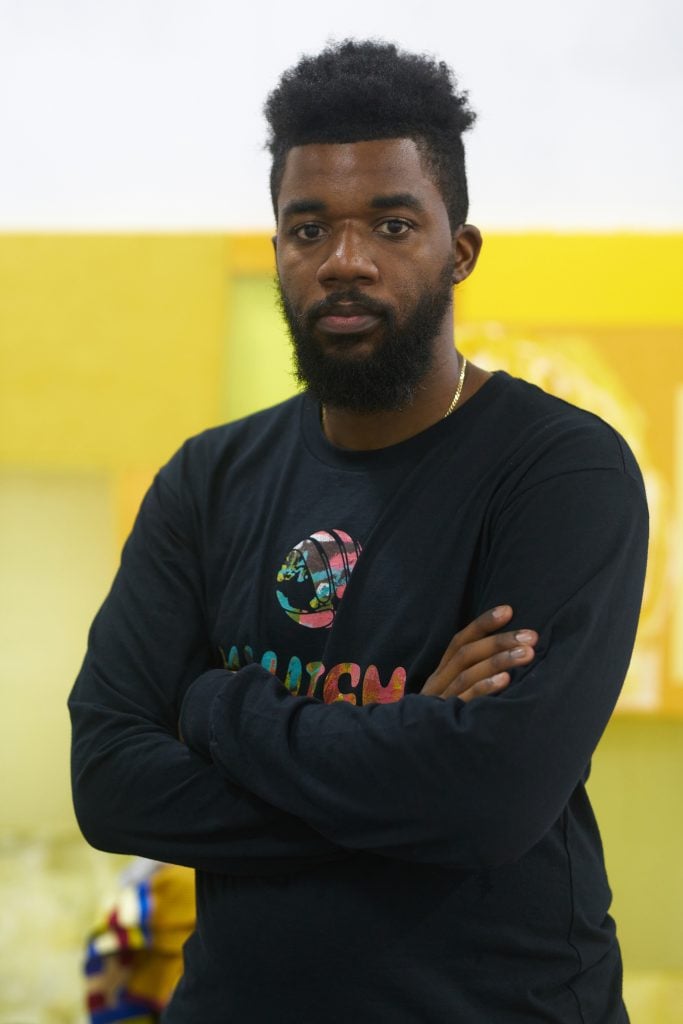
Alston explains how he found his style, and the mission he sees for his work today.

Folasade Ologundudu

This article is part of a series of interviews by Folasade Ologundudu exploring the evolving conversation about abstract art among Black artists across different generations.
At just 30, the art of Patrick Alston is already immediately identifiable, with a signature materiality and use of gestural marks to create dynamic and colorful abstractions. The central themes of his varied body of work are identity, process, environment, and color theory.
The South Bronx native attended Wabash College in Crawfordsville, Indiana, where he studied both art and psychology. He currently lives and works between the Bronx and New Haven, Connecticut where he recently set up a large studio. He attended the Gallery 1957 artist residency in Accra, Ghana this summer, while his first solo exhibition, titled “Let There Be Light” and curated by Larry Ossei-Mensah, was seen at Ross + Kramer Gallery in Chelsea.
For that show, Alston presented his first installation piece, moving beyond painting and incorporating art found objects and discarded materials sourced throughout his Bronx neighborhood and surrounding areas. “For Sale” and foreclosure signs, construction materials, and objects used in the creation of new luxury high rises highlighted the juxtaposition of poverty with the influx of economic wealth in low-income areas of the Bronx that continue to displace members of his local community.
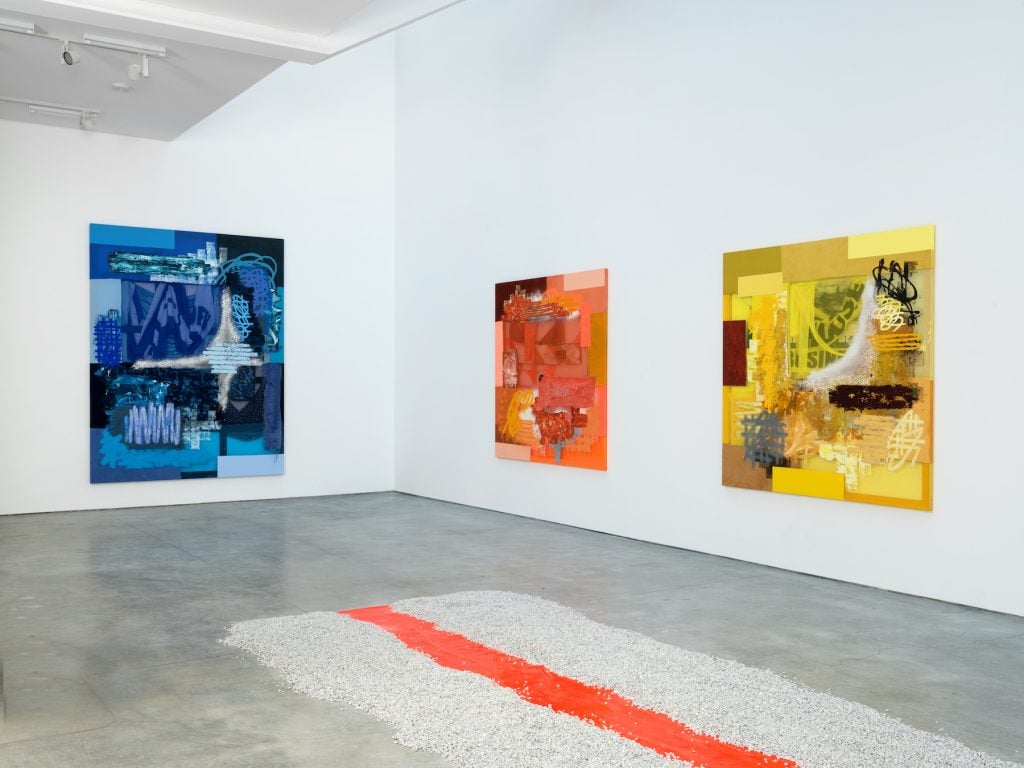
Installation view of “Patrick Alston: Let There Be Light” at Ross + Kramer. Photo courtesy Alston Studio.
Speaking recently, Alston shared with me the ways in which his interest in abstraction has challenged him to dig deeper in his practice, channeling his ideas through materiality and gesture. He also explained how his everyday life led him to focus attention on inequities present both within the art world and in society at large.
What drew you to the language of abstraction as a means to communicate your ideas?
I first became interested in abstraction while studying in undergrad. That’s where it all began—but while in undergrad I didn’t practice abstraction. It was a mysterious language and I had to crack the code. It was intimidating for me. I disregarded it, to be honest, because I didn’t understand it. It wasn’t until after school when I began to study and experiment on my own.
Can you speak a little bit more about why abstraction was a challenge for you?
It was a challenge because I hadn’t had exposure to it. When you first come across a new language it takes time to study that language, to understand those who founded the language of abstraction. It was difficult for me to see the relevance or importance of art that didn’t necessarily have a subject or a direct narrative. It was difficult to understand the fascination around it until I began to practice it, to learn more about the movement itself. Then it clicked. I realized abstraction was the method of creating that I related to the most, as a way to relay my own experiences in this world.
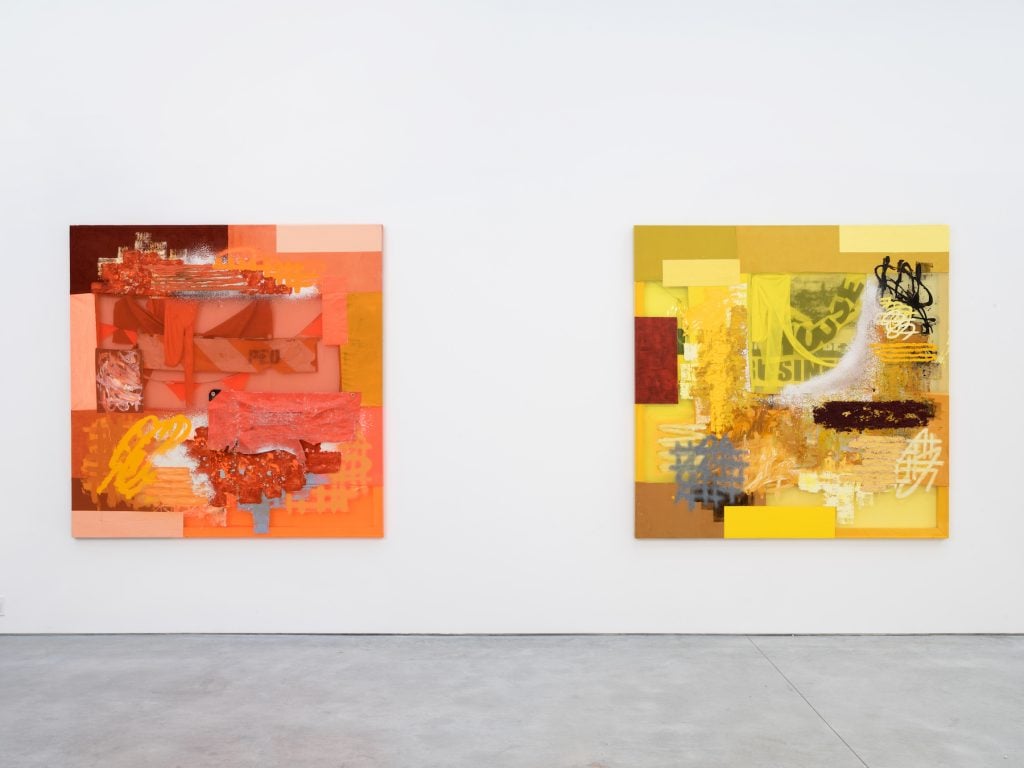
Installation view of “Patrick Alston: Let There Be Light” at Ross + Kramer. Photo courtesy Alston Studio.
Why don’t you make figurative work? What are some of the main differences between abstraction and figuration?
I think figuration for me limited the subject matter that I could speak about. Abstraction gave me room to take all the ideas I had, all the subjects I was interested in and to be able to think about and respond to them, but not necessarily with a literal depiction.
For me, the main difference between abstraction and figuration is that, while they both are built upon the building blocks of painting and creating shape, abstraction doesn’t exist in the three-dimensional world. I think figuration builds upon that which already exists and either tries to replicate or manipulate things we see.
There was a disconnect that I had with figuration because it didn’t spark anything for me. Some of my favorite painters are figurative painters, but in my own practice, it didn’t engage me.
How does that appreciation of figurative painters filter into your own work? Does it come about in terms of the use of materiality or in other ways?
As an artist you look at everything. You go to a museum and you look at a Rembrandt or a Monet and you can pull from these painters, whether it’s just pulling a color, a texture, or a gesture. I pull from so many areas to create my works. I think that’s how we continue to build the language of art and what the language of painting will be.
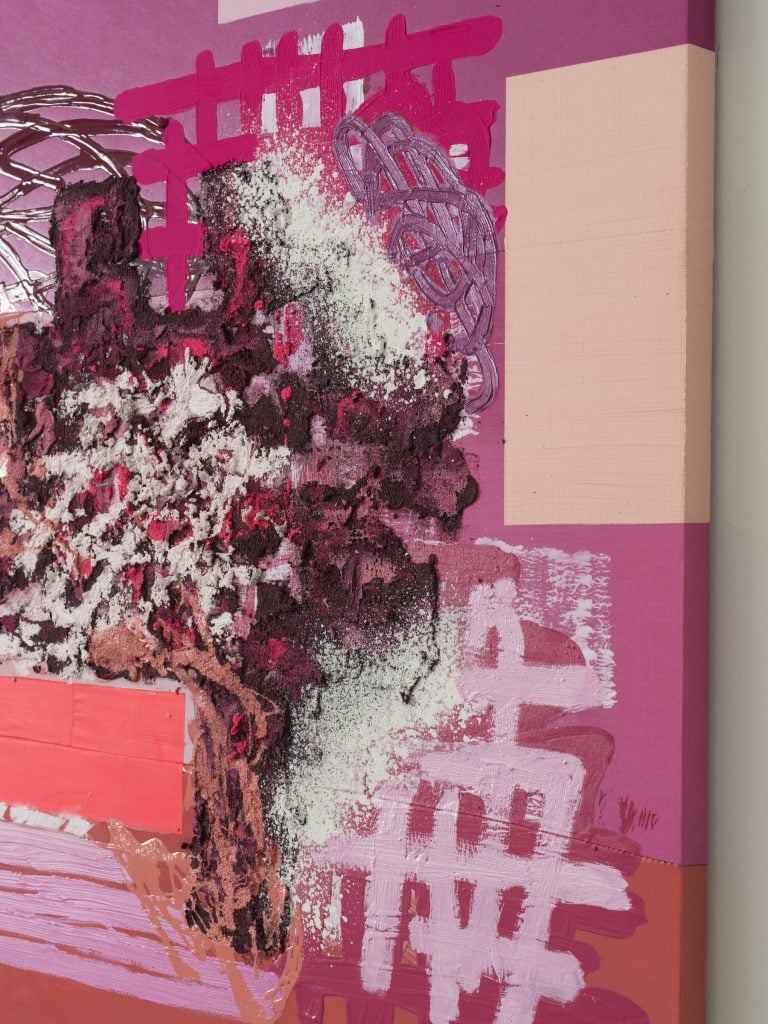
Detail of a work by Patrick Alston. Image courtesy Alston Studio.
Which abstract painters have influenced you and why?
Philip Guston is one of the first abstract painters I fell in love with. People like Raymond Saunders and Jack Whitten understood the process of painting as being a process within itself. It’s not necessarily about the finished product. It’s about the process of arriving at that finished product.
Guston describes it as a moment in which the “third hand” takes over. As he describes it, the “third hand” is a subconscious state that you arrive at during your process, when you get into that subconscious state of creating but you can’t necessarily describe how it happens. It’s almost like a basketball player who gets in the zone. I’ve always found myself being engaged with that process while working in abstraction.
Did you study abstraction in school—and more importantly, did you learn about Black abstract artists?
I did learn about abstraction—just not to the extent I would have wanted. And it wasn’t until I came out of school. Looking back, I’m happy it happened that way because after graduating and beginning the process of self-education, I saw a reflection of my practice within these Black abstractionists who were working, and I appreciated coming across their work and being able to learn about it on my own. But I did not learn about any Black abstractionists while at school.
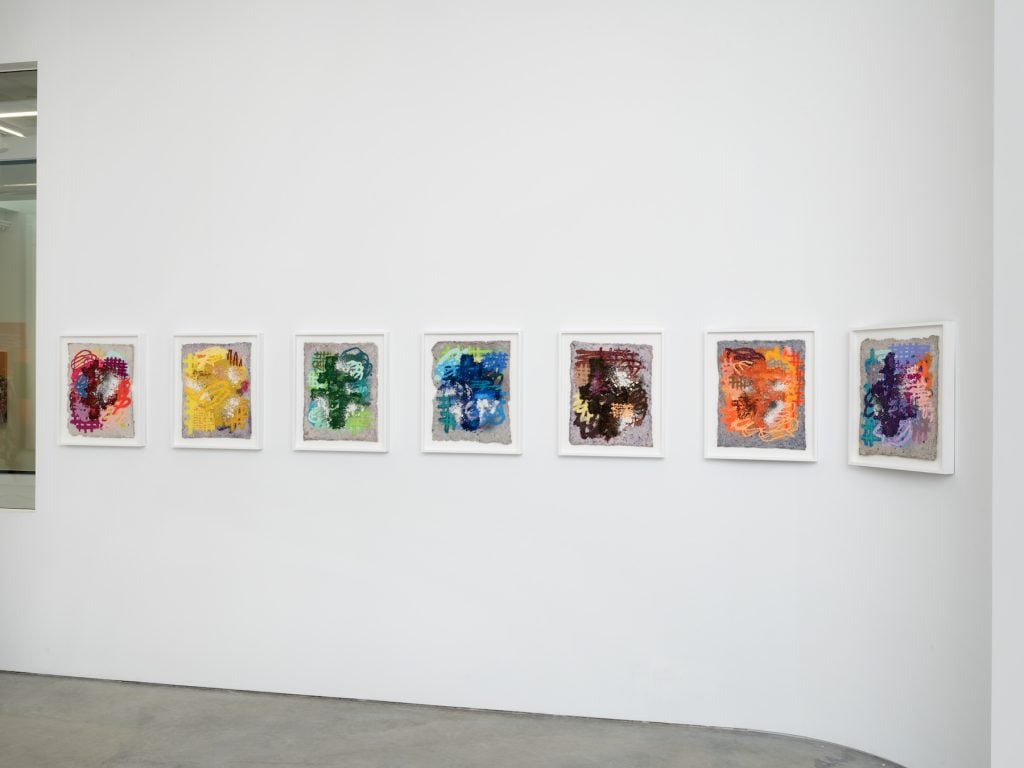
Installation view of “Patrick Alston: Let There Be Light” at Ross + Kramer. Photo courtesy Alston Studio.
And how do you think that that has affected you?
I think it lit a fire within me after having graduated and learning about these painters and asking, “why didn’t I learn about these brilliant artists?” The Stanley Whitneys of the world, the Raymond Saunders, the Mark Bradfords, the Jack Whittens—these are some of the most brilliant minds I’ve ever come across. It lit a fire in me about the importance of us looking at Black abstraction as a subject in itself.
For me, one of my missions is to continue to push the conversation forward so that those who come after me are able to see themselves the way I saw myself in these artists after school—but also while in school and even going in. There are articles coming out about artists like Howardena Pindell who are just now getting their due. And it’s disappointing when you see these bodies of works and their commitment to the craft and then see where they still sit within the conversation.
What are your thoughts about Black artists being forced to self-educate because traditional art programs lack scholarship around African-American art?
For one, it exposes flaws in the educational system. A lot of us are leaving school with these huge debts and it exposes the need for institutional change. It’s unfortunate that I had to go and self-educate after having gone through a four-year institution and never having learned about these artists.
But I also began to look at myself and question, “how can I infiltrate these institutions in order to make sure that these subjects are being taught?” I don’t know if it’s necessarily through a process of lobbying or taking the burden upon myself and going into these institutions to teach. But it’s something that clearly needs to be changed. My experience in this is not unique. Many people go through it.
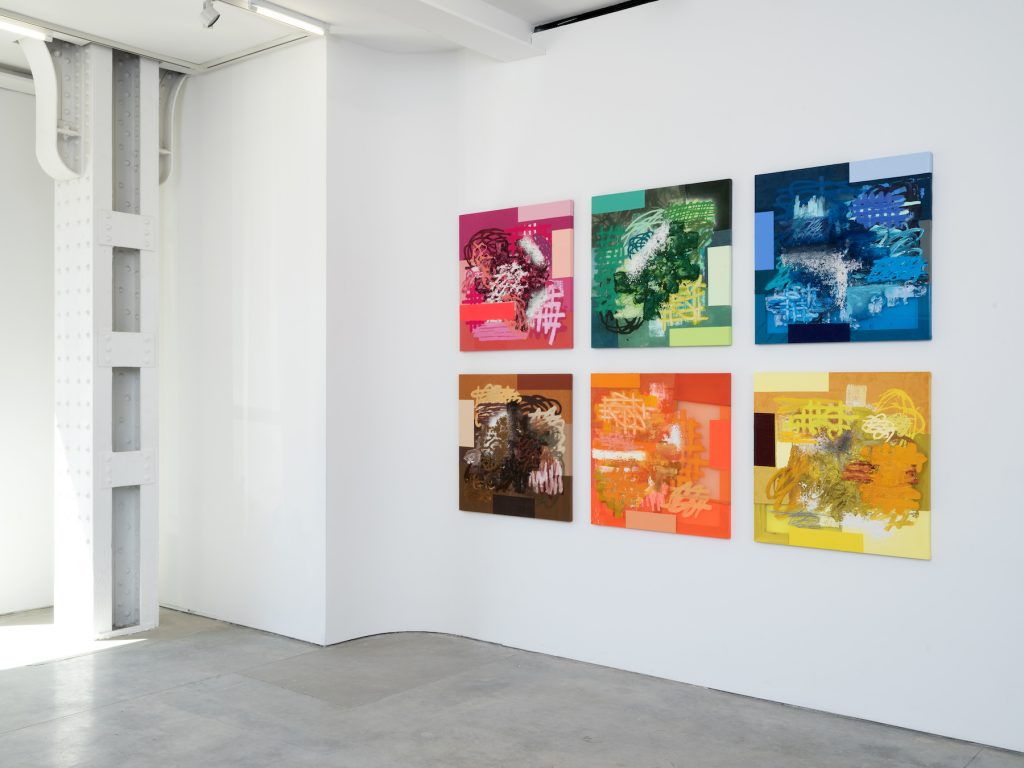
Installation view of “Patrick Alston: Let There Be Light” at Ross + Kramer. Photo courtesy Alston Studio.
Right. And not only do artists of color have to work harder to be noticed and taken seriously but they also have to work harder to learn about things that white artists have access to. Our educational system does such a disservice to Black and Brown students by not properly recording and teaching our histories. The teaching of art is historically rooted in whiteness and in maleness.
Looking at the history of art, it has always been a catalyst for speaking about the issues of the day within a society. I think the reason why certain artists aren’t spoken about and put in history books and textbooks is clear. That’s why the idea of self-education is very important. It’s also important for us as artists, writers, and curators to infiltrate those systems and speak to what’s going on. I’m passionate about the subject of Black abstraction and I feel it’s my mission to have important conversations around what a Black artist is and can be.
Do you feel very mission-driven in your work?
The work gives me access to people in institutions, to give back to my community. It’s become my mission to push the narrative forward for equality and equity. Art gives us access to provoke change.
How has the process of self-education lent itself to your art practice? How much of the way you approach art-making has evolved from your lived experiences as opposed to an academic understanding of art?
Academia was a place for exposure, but now it’s more about my lived experiences. Self-education helped me to draw conclusions and correlations between different artists and subjects in a way that being in school didn’t.
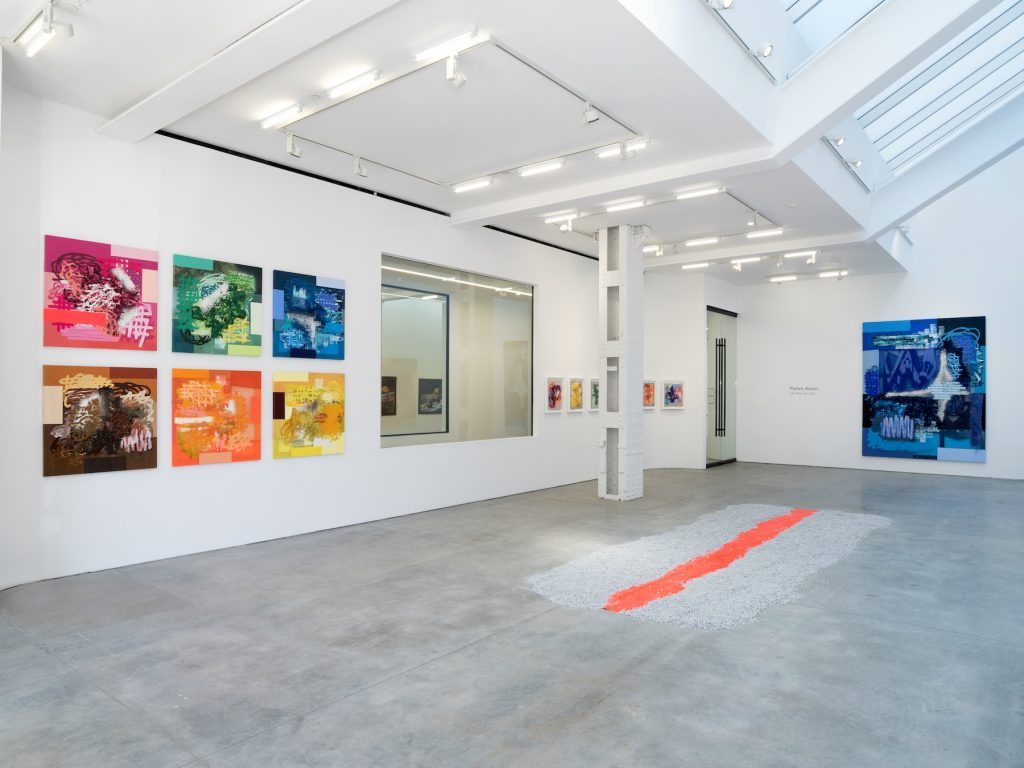
Installation view of “Patrick Alston: Let There Be Light” at Ross + Kramer. Photo courtesy Alston Studio.
Much of your current work reflects on your immediate community. How does your use of materiality speak to and comment on your surrounding community?
I was looking for a way to speak about identity and my environment. At one point I started to use some of the things that I come across within my everyday existence. I’m finding materials that I pick up off the street. Introducing new materials into the works helps me to put my lived experiences in my work.
Where do you live now?
I’m from the South Bronx. I’ve lived there for a majority of my life. I moved to New Haven, Connecticut when Covid hit and now I’m back and forth between the Bronx in New Haven. The interesting thing is in the communities of New Haven I’ve felt some of the same energy that I felt in the South Bronx.
Is that a simple way of saying that no matter where you go in America, Black life is the same?
Yes. You hit it right on the head. Especially within cities. I am finding that the experiences are exactly the same whether in education, or in the nature of how well the streets are kept and how much the city gives to cleaning certain areas.
I’m bringing that sort of imagery into my work. When I go back to the neighborhood I grew up in it’s the same people who are living in the same conditions that I’ve become accustomed to for the majority of my life.
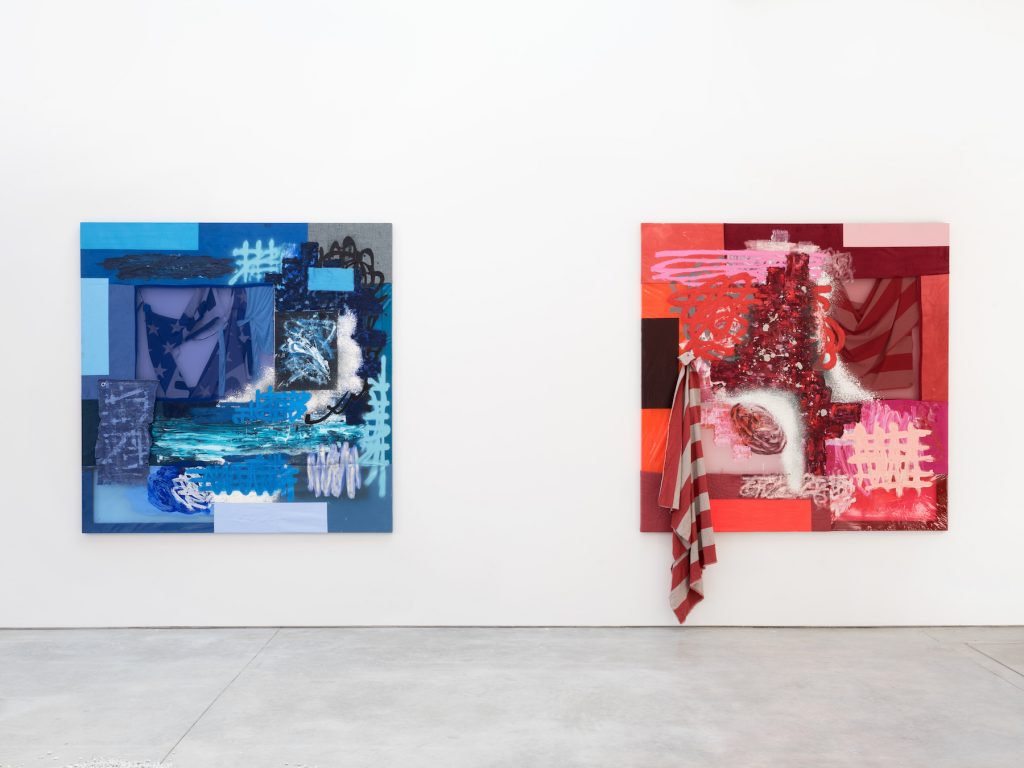
Installation view of “Patrick Alston: Let There Be Light” at Ross + Kramer. Photo courtesy Alston Studio.
What are some of the biggest challenges that you are presented with when trying to translate these ideas through abstraction?
When I’m creating I’m thinking about different subjects. If I’m frustrated about a subject—let’s say, social injustice—there may be gestures or colors I use while being stimulated by my frustrations. But when audiences come in, when they come in to view the work, if they don’t have access to being able to speak to me or have access to reading something about the work, it just doesn’t translate. That, I think, is the deficiency of abstraction: the connection between this artifact that is presented to audiences and the audience’s interpretation of this artifact.
You closed your first solo exhibition in New York at Ross + Kramer Gallery this past summer. What were you working through in the show?
I was working through the period of time after Covid while going from my home to my studio in the South Bronx. A lot of new high rises were being built. Luxury condos were being built at the same time that I was seeing local stores, local supermarkets, and small businesses being closing and suffering from the pandemic. I was watching people suffer through mental health issues within my community, watching a level of violence within the community become exasperated by lockdown.
I began to take some of these things that I saw within the environment, the “Open House” signs, the “Business Closing” signs, the “Everything Must Go” signs, taking these symbols of this period of time that we’re living through and creating work around it. And, more importantly, this show was about access to light, from a metaphysical standpoint, and access to light, physically, where these high rises were being built and casting shadows in these areas. I don’t think we’ve really thought enough about what removing light from communities does to people from a mental health standpoint.
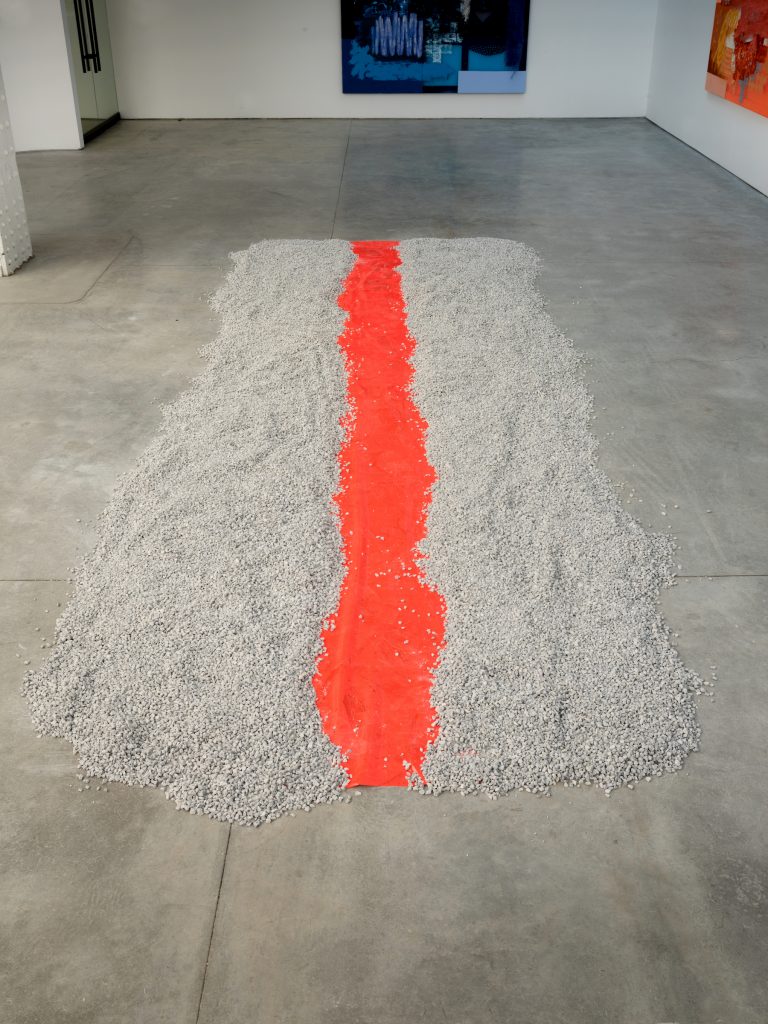
Installation view of Patrick Alston, Red Sea. Photo courtesy Alston Studio.
In this recent show you’ve created a piece that’s a departure from anything you’ve ever done: your first installation. Can you speak a little bit about that?
The installation was titled Red Sea. Throughout American history people don’t necessarily appreciate how they contribute to the overall plight of Black Americans. That piece is speaking about the figure of Moses in the Bible as a counterpoint to [urban planner] Robert Moses.
The freeways [Robert Moses built] through the Bronx—the Cross Bronx Expressway—displaced many families and continues to this day to pull down the price of real estate within that area because of the amount of pollution and cars that pass through. From a health and socioeconomic standpoint, the kind of families that have been displaced because of this project is no coincidence. We just have to call it what it is: these are racist acts.
I was thinking about the difference between the parting of the Red Sea and the parting of the South Bronx, and how these two different Moses figures share this name but are very different. The piece was speaking about Robert Moses splitting up the Bronx, but also speaking about the redlining that affected these same areas as well. You can’t really separate the past from the present and the piece spoke to that.